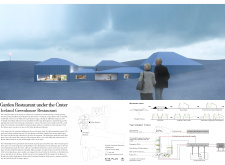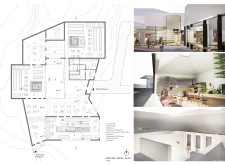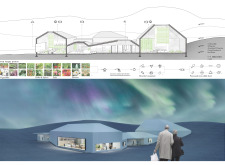5 key facts about this project
The architecture of the restaurant is shaped to echo the forms found in the Icelandic landscape, particularly the characteristics of volcanic craters. The structure is characterized by its geometric forms and sloped roofs, which complement the rugged scenery, while the use of natural materials creates a cohesive relationship between the building and its context. An emphasis on visibility and transparency throughout the design fosters a sense of openness; patrons can observe the hydroponic greenhouses and the kitchen area, promoting an educational element about sourcing food locally and sustainably.
The layout of the Garden Restaurant has been carefully organized to improve the overall dining experience. Indoor and outdoor spaces are seamlessly connected, allowing guests to engage with nature. The design includes distinct areas for dining, with various seating configurations that can accommodate both intimate gatherings and larger groups. The highlight of the restaurant is undoubtedly the integrated greenhouses, where fresh produce is cultivated on-site, reinforcing the concept of farm-to-table dining. This not only allows chefs to utilize ingredients at their peak freshness but also provides an immersive experience for diners, connecting them with the food's journey from growth to preparation.
In terms of materiality, the project primarily employs concrete, glass, steel, and wood. The exposed concrete used for structural elements provides durability and visual appeal, while glass fills the space with natural light and provides stunning views of the surrounding landscape. Steel elements are strategically placed for structural reinforcement without compromising the aesthetic, and wood, particularly reclaimed or bamboo options, is used in the interior to add warmth and comfort. Green roofing systems, which utilize local vegetation, further enhance the building's thermal performance and help it blend into the environment.
Sustainability is woven throughout the design and operational strategy of the Garden Restaurant. Geothermal energy plays a crucial role in heating, while solar panels supplement electrical needs, showcasing a commitment to renewable energy solutions. Rainwater harvesting systems have been integrated into the design to reduce water consumption, further aligning with the restaurant's ecological goals. This multifaceted approach to sustainability is intended to set a standard for future projects aiming for reduced environmental impact.
The unique design approaches of the Garden Restaurant extend beyond its physical form. It embodies a philosophy that encourages interaction — between people, food, and the environment. Culinary adventures await diners as they can see and understand the production of their meals, inherently fostering a deeper connection to food and its origins. The presence of edible landscaping surrounding the venue supports this philosophy by allowing guests to engage directly with their food source.
The Garden Restaurant under the Crater represents a thoughtful convergence of sustainable architecture, innovative design, and culinary experiences that reflect the distinctive aspects of Iceland's natural environment. By blending functionality with a deep respect for the landscape, this project serves as a model for future developments in both architectural and environmental practices. For those interested in exploring the complexities and nuances of this project, the architectural plans, sections, designs, and ideas provide a wealth of information that reveals the many layers of thought that have been infused into this unique establishment.


























